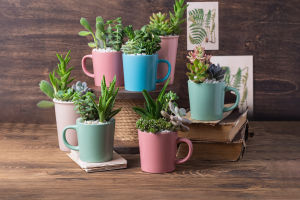Growing succulents have become increasingly popular, thanks to their exquisite appearance and adorable chubby look, making them quite appealing.
When placed indoors, they serve as artworks, creating a unique focal point. So, how do you cultivate succulents?
1. Succulents are well-suited to bright sunlight and require minimal water, making them ideal for environments that replicate their native arid conditions. They experience active growth in spring and fall, warranting slightly more frequent watering during these growth periods. It's best to water succulents in the cooler hours of morning or evening. The key watering rule is to allow the soil to completely dry out before re-watering and to water thoroughly each time.
Due to their water-retaining leaves, succulents don't require frequent watering—once a week is usually adequate, though this may vary based on local climate and indoor conditions. When using clay pots, which dry out more quickly, you might need to water the plants more often. For pots lacking drainage holes, adding a layer of large stones at the base can help prevent water from accumulating and protect the roots from rot, ensuring the longevity of the plants.
2. Soil for succulents: Succulents prefer well-ventilated and permeable soil. You can use soil mixed with larger particles such as crushed coal balls soaked in water and mixed with peat. If possible, you can create your succulent soil mix using fruit and vegetable peels.
Layer fruit peels and vegetable peels with soil, and after a few months, it will turn into fertile soil suitable for succulents. If you gather soil from a natural environment like a small forest, it's advisable to sterilize it to prevent any insect eggs that may affect plant growth.
3. Key points for mixed planting: Mixed planting of succulents can be visually appealing, but when doing so, it's important to avoid planting species with vastly different habits together. Ideally, plant species with similar characteristics and from the same botanical family together.
For example, plants that dislike direct sunlight, like jade plants, are not suitable for mixed planting with sun-loving succulents. Plants with different water requirements should also not be planted together, as it may affect their growth.
4. For beginners, starting with some common and affordable succulent varieties like Haworthia, Echeveria, and Crassula is recommended. These plants have high survival rates and are perfect for novices.
Cultivating succulents not only beautifies your indoor space but also creates an artistic focal point. Proper watering, selecting well-draining soil, and understanding plant habits are key to successful cultivation. For beginners, starting with affordable and easy-to-care-for varieties is a wise choice. The beauty and charm of succulents will bring endless joy and surprises to your life.


